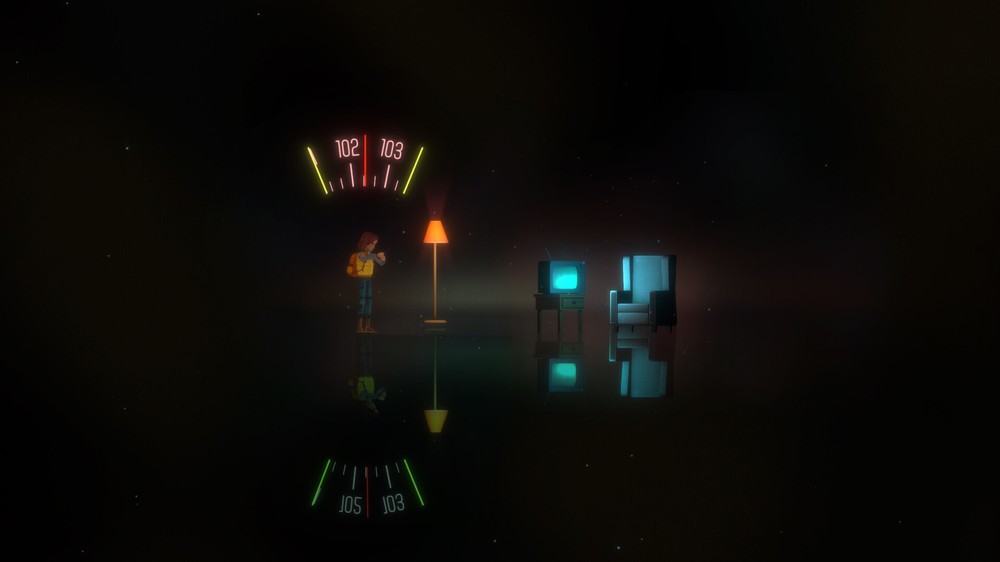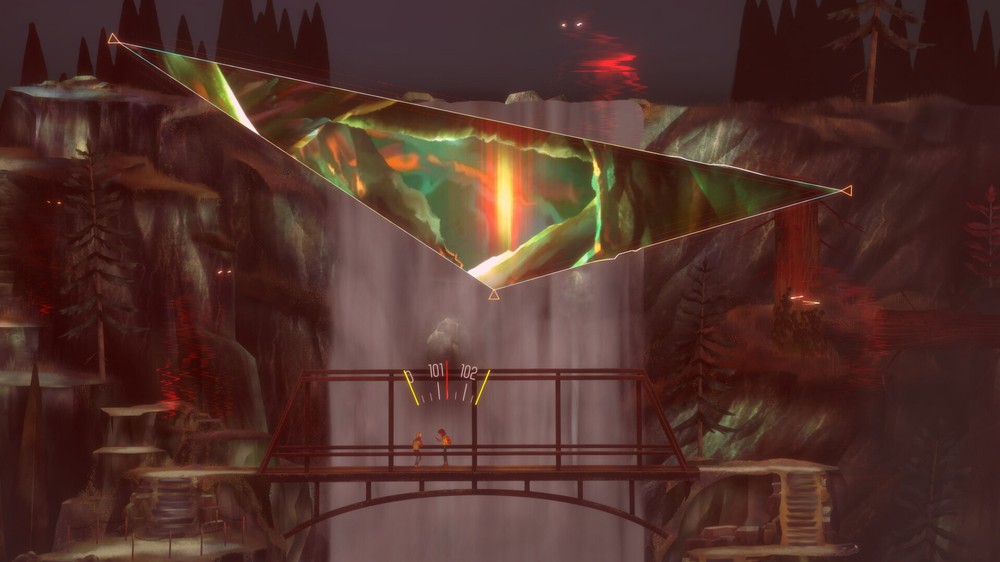Oxenfree is a spooky coming-of-age story about teenage angst and dealing with grief. With it, Night School Studio made a name for itself, demonstrating great skill in storytelling with their writing and their intelligent conversation system. Backed by a colorful world and a moody synth soundtrack, Oxenfree was easily a top indie game in 2016. Seven years and one Netflix acquisition later, Oxenfree II: Lost Signals rolls in hitting many similar notes as its predecessor. At its core, it’s more Oxenfree. The dialogue is great, there are plenty of radio-based puzzles, and the atmosphere is still creepy. You’d be forgiven if you saw both titles side-by-side and couldn’t pick them apart. Therein lies my main issue with Oxenfree II. It’s caught somewhere between wanting to be a standalone entry in the series and wanting to be a sequel, but its inability to pick a lane keeps it from standing out as either.
Riley Poverly is a thirty-something returning to her home island of Camena at the start of the game. She’s returned for work, placing transmitters around the island as part of a conservation group. Accompanying her through much of the narrative, is Jacob Summers, Riley’s former classmate who has lived his entire life on the island. After placing their first transmitter, Riley and Jacob find themselves stuck in a time loop like the protagonists of the first game. Oxenfree II’s shift from teenagers to mid-aged adults, opens up the door to explore more themes around Coming-of-age, mortality, and missed opportunities. I immediately related with Riley and Jacob. Their fears of the future and how their checkered pasts may blemish those futures rang true to me as a fellow thirty-something. It also really helps that the chemistry between them feels so natural, mostly due to Jacob and Riley spending most of the game together.

If you played the original Oxenfree, you already know you’re in for a lot of walking and talking. This is where the game shines. The intelligent conversation system keeps things flowing between Riley and Jacob as you traverse Camena Island. Even when the conversation is interrupted by interacting with something in the environment, the game smoothly transitions between topics. Riley and Jacob playing a one-word story game while exploring a ghost town sounds cheesy on paper, but in practice, Oxenfree II sells the hell out of it.
New to the series, Riley has a walkie talkie that allows players to interact with additional characters throughout the adventure. These characters include an environmentalist, a park ranger, and a high school FM radio talk show host, just to name a few. You never personally meet any of these characters but can interact with them throughout the night. These conversations give a glimpse into each character and can ultimately lead to Riley making decisions on their behalf. You can go through the entire game and miss most of these conversations if you’re not diligent about checking your radio. These additional characters add some depth to the world and play into themes of external influences on people. Riley’s interactions on the radio mirror the interactions the game’s antagonist has throughout the narrative. Avoiding spoilers as much as I can. Night School Studio plays around with the idea of communication with outer circles and how those interactions can change your inner circles. I personally love this thread and think it’s a strong throughline for the game, if you ignore how it blends with the original Oxenfree.

You discover early that Camena Island neighbors Edwards Island, the setting of the original game. Set five years after Oxenfree, the sequel immediately gets into the supernatural elements. At this point, I assumed I wouldn’t need to remember much about the original. The set up feels like it’s establishing that we are in the same world, but that this is a standalone story. A lot of time is spent getting to know Riley, Jacob, and the group of teens that serve as the game’s antagonists. I was totally caught off guard when more elements from the original came into play in the back quarter of Oxenfree II. I don’t know if I should be mad at myself for not replaying a seven-year-old game or mad that there isn’t an accompanying recap, but it does feel like I was missing a few things with the original not fresh on my brain. That turn in focus also takes away from Riley, Jacob, and Oxenfree II as a whole. While I related to these characters, I didn’t feel like I really knew them. I knew Riley was at odds with a family member, I didn’t know what was central to that conflict, just that she was avoiding it. These back half developments ultimately make Riley and Jacob feel like side characters in their own game.
On the gameplay side, there are a few additions to help try and set Oxenfree II apart from the original. On top of the aforementioned walkie talkie, there are areas on the island where climbing is essential for forward progress. This gives us interesting character moments between Riley, a climber, and Jacob, a guy with the fear of falling. This also breaks up the walking and talking, if only for small segments. There are a few areas where Riley and Jacob can travel through time to access closed off areas. One specific area has you opening time rifts, trying to determine the year in which a closed mine shaft is still open. Guessing wrong sends you into the distant past, pre-mine. These moments add some variety to the puzzles throughout the narrative and change things up from the normal creepy atmosphere we come to expect from Oxenfree. I just wish there were a few more moments like them.

Artist, Scntfc returns for Oxenfree II’s score. Again, he hits the mark on creating a memorable soundtrack that fits the mood of the world. The voice acting is top notch. Across the board, the cast delivers. Elizabeth Saydah as Riley and Joe Bianco as Jacob, sell the chemistry between their characters in amazing performances. Saydah and Bianco bounce off each other like they could hold an endless conversation for years. Oxenfree II has that muddy watercolor look that resembles the first game. I think things are a little brighter here, but the game still looks amazing. The glow of the moon over a hazy landscape is beautiful and creepy at the same time. The diversity of Camena Island’s surrounding area offers a little more variety in visuals this time around. From a large park to a handful of caves and mines. There are a few set-pieces throughout the 5-6 hours you’ll spend with the game. One in particular plays around with space and climbing. Again, I won’t spoil anything, but these moments create that creepy supernatural vibe and create fun back-and-forths between each character.
Oxenfree II: Lost Signals is a rare occurrence where I believe you will get more enjoyment out of it, if the original game is fresh on your brain. It’s a solid game from the gameplay side of things. The music, voice acting, and art design give their all here. On the narrative end, it feels like it is trying to be two different things and those things are in conflict with one another. This ultimately gets in the way of leaving a lasting impression, which in a narrative about leaving lasting impressions, feels like a miss.











